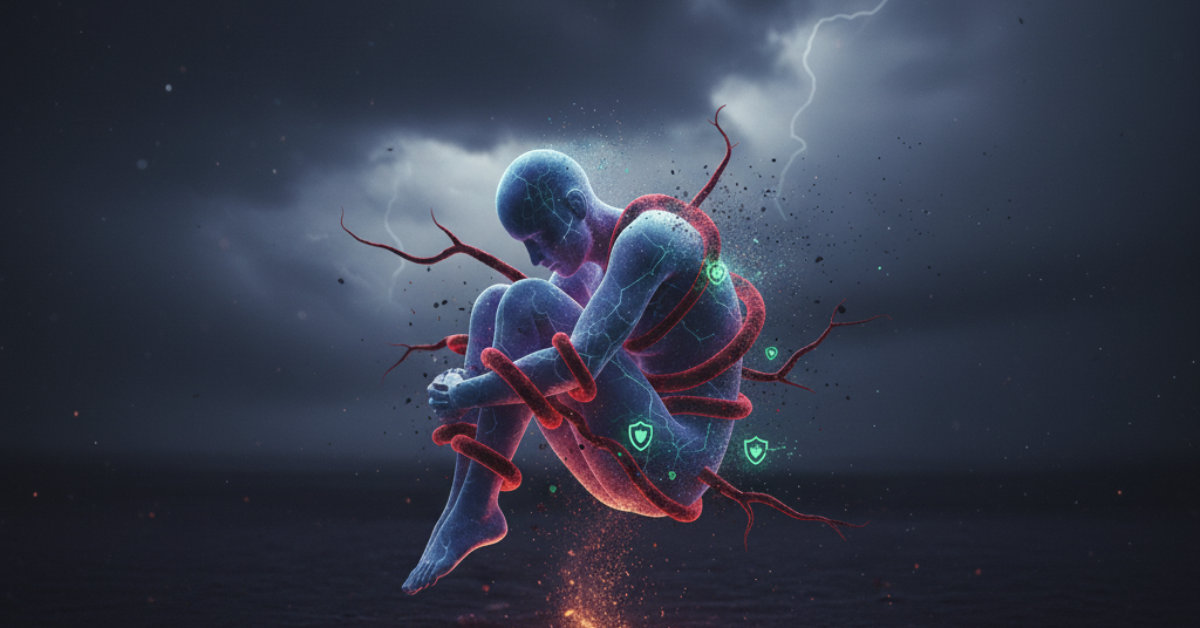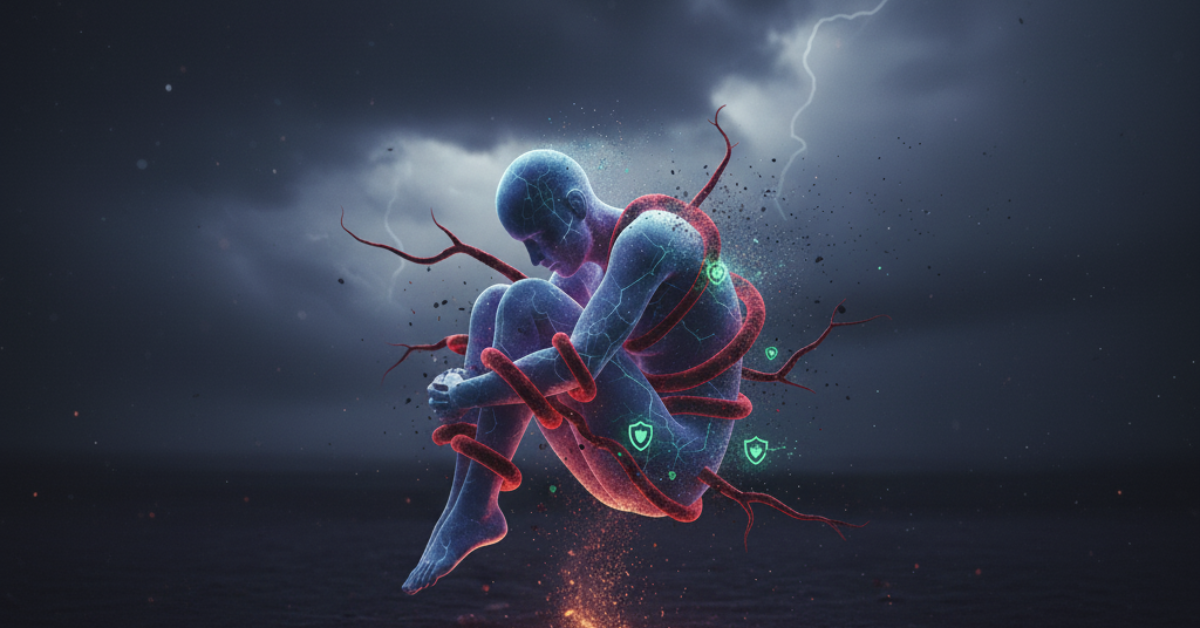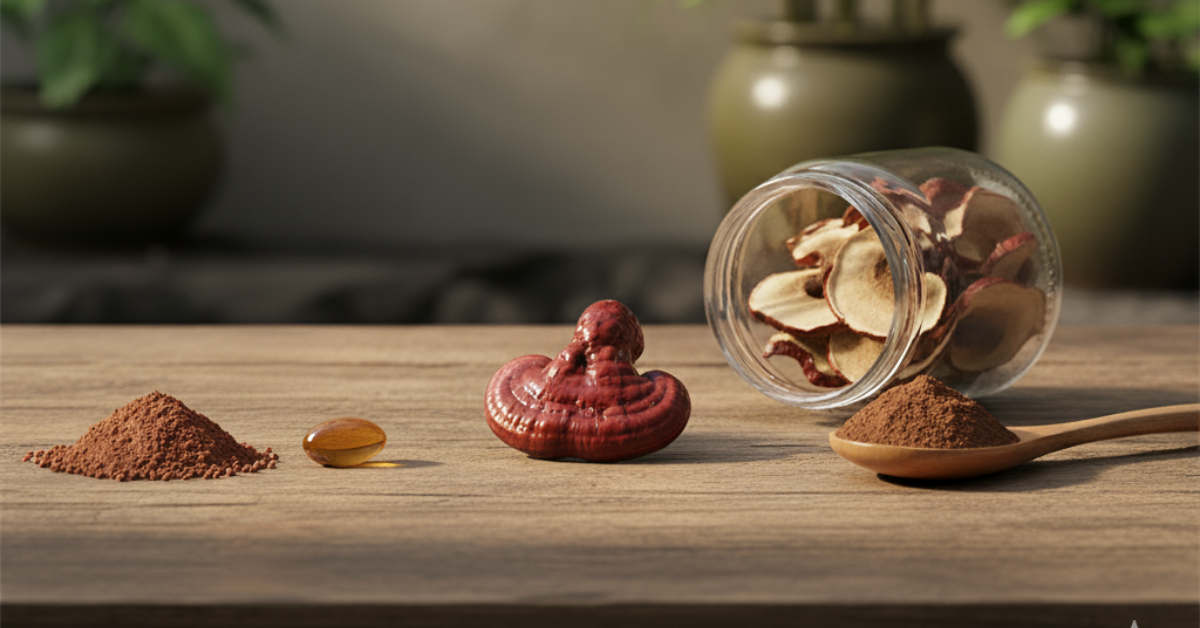Imagine your body as a fortress under siege—but instead of external enemies weakening your defenses, the attack comes from within. Chronic stress doesn't just make you feel overwhelmed; it systematically dismantles your immune system while draining your energy reserves, creating a dangerous cycle that leaves you increasingly vulnerable to illness, infection, and disease.
If you've ever noticed that you get sick more often during stressful periods, or that chronic fatigue seems to go hand-in-hand with frequent infections, you're witnessing this vicious cycle in action. The connection between stress, energy depletion, and immune dysfunction isn't just coincidental—it's rooted in complex physiological mechanisms that researchers are only now beginning to fully understand.
In this comprehensive guide, we'll explore the hidden ways chronic stress sabotages your body's most critical defense systems, reveal the four-stage cycle that traps millions in a pattern of declining health, and most importantly, uncover evidence-based strategies to break free from this destructive pattern and rebuild your natural resilience.
The Hidden Battlefield: How Stress Wages War on Your Immune System
The Cortisol Connection: Your Body's Double-Edged Sword
When stress strikes, your body's first response is to flood your system with cortisol—a hormone designed to help you survive immediate threats. In acute situations, this response is lifesaving. However, when stress becomes chronic, cortisol transforms from protector to saboteur.
Research reveals that chronically elevated cortisol levels create profound immune suppression through multiple pathways:
-
Vaccine efficacy drops by 40-60% in chronically stressed populations, highlighting how stress compromises your ability to build immunity
-
Type 1 cytokine production becomes severely suppressed, weakening your body's antiviral responses
-
CD8+ T-cell activity plummets, reducing your natural defenses against cancer cells
-
Natural killer (NK) cell cytotoxicity decreases significantly, leaving you vulnerable to infections and malignancies
The mechanism behind this suppression involves glucocorticoid receptor dysfunction. As cortisol levels remain elevated, these receptors become desensitized, creating a state of "cortisol resistance" where your body requires increasingly higher levels to achieve the same regulatory effects—similar to insulin resistance in diabetes.
The Cellular Energy Crisis: When Your Immune System Runs Out of Fuel
Perhaps even more insidious than cortisol's direct effects is how chronic stress depletes the cellular energy required for optimal immune function. Your immune cells are among the most metabolically active in your body, requiring enormous amounts of ATP (cellular energy) to:
-
Mount effective responses against pathogens
-
Produce antibodies and cytokines
-
Proliferate rapidly during infections
-
Maintain surveillance functions
Chronic stress creates what researchers call "immunometabolic paralysis"—a state where immune cells simply lack the energy to function effectively. Studies show that:
-
Mitochondrial dysfunction in immune cells reduces antioxidant defenses by up to 50%
-
ATP-dependent immune processes become severely compromised during chronic energy depletion
-
Lymphocyte proliferation becomes impaired, reducing your ability to mount immune responses
This energy crisis doesn't happen overnight. It develops gradually as chronic stress depletes key cofactors and nutrients essential for cellular energy production while simultaneously increasing energy demands through persistent inflammation.
The Four-Stage Vicious Cycle: Understanding the Downward Spiral
Stage 1: HPA Axis Overactivation
The hypothalamic-pituitary-adrenal (HPA) axis—your body's central stress response system—becomes hyperactive under chronic stress. Initially, this may even boost certain immune functions, which explains why some people feel "wired but tired" and may initially seem to handle stress well.
Stage 2: Cortisol Resistance and Immune Suppression
As cortisol receptors become desensitized, your body enters a state of functional cortisol deficiency despite high circulating levels. This paradoxical state leads to:
-
Increased production of immunosuppressive regulatory T cells (Tregs)
-
Th1/Th2 immune imbalance favoring allergic responses over anti-infection immunity
-
Reduced NK cell activity, increasing infection and cancer risk
Stage 3: Cellular Energy Crisis
Persistent stress depletes the nutrients and cofactors essential for cellular energy production while simultaneously increasing energy demands through chronic inflammation. Immune cells begin to "starve" at the cellular level, unable to mount effective responses.
Stage 4: Persistent Inflammation and Accelerated Aging
With immune surveillance compromised and cellular repair mechanisms failing, low-grade inflammation becomes chronic. This creates a self-perpetuating cycle where inflammation itself becomes a stressor, furthering HPA axis dysfunction and immune suppression.
Recognizing the Warning Signs: Biomarkers of Immune-Energy Depletion
Understanding the early warning signs of this vicious cycle can help you intervene before severe immune compromise develops:
Physical Symptoms
-
Frequent infections lasting longer than normal
-
Slow wound healing
-
Persistent fatigue that doesn't improve with rest
-
Unexplained muscle weakness
-
Cold hands and feet (circulation issues)
-
Sleep disturbances despite exhaustion
Laboratory Markers
-
Elevated cortisol levels (particularly evening cortisol)
-
Low DHEA-S (indicating adrenal depletion)
-
Reduced NK cell activity
-
Elevated inflammatory markers (CRP, IL-6)
-
Low vitamin D levels
-
Depleted B-vitamins and minerals
Immunological Signs
-
Individuals with chronic stress show a 3x higher risk of viral infections
-
Reactivation of latent viruses (like Epstein-Barr or herpes)
-
Increased susceptibility to seasonal illnesses
-
Poor response to vaccinations
-
Development of autoimmune symptoms
Breaking the Cycle: Evidence-Based Natural Interventions
Restoring HPA Axis Balance
The foundation of recovery involves normalizing your stress response system through targeted interventions:
Circadian Rhythm Restoration:
-
Light therapy upon waking
-
Darkness 2-3 hours before bed
-
Consistent sleep-wake cycles
-
Strategic meal timing
Adaptogenic Support:
Traditional adaptogenic herbs have shown remarkable ability to modulate HPA axis function. Research demonstrates that ashwagandha can reduce cortisol levels by up to 30% while improving energy and immune markers.
Cellular Energy Restoration
Mitochondrial Support:
-
Alpha-lipoic acid (600mg daily) has been shown to enhance mitochondrial function in lymphocytes
-
CoQ10 and PQQ support cellular energy production
-
Magnesium and B-vitamins serve as essential cofactors
Targeted Nutrient Repletion:
-
Vitamin D3 (2000-4000 IU) for immune modulation
-
Zinc (15-30mg) for immune cell function
-
Selenium for antioxidant enzyme production
The Role of Traditional Medicine in Modern Stress Recovery
Traditional Chinese Medicine offers particularly sophisticated approaches to addressing the stress-immunity-energy connection, recognizing these systems as fundamentally interconnected rather than separate.
Key Therapeutic Mushrooms and Herbs
Cordyceps Sinensis:
Modern research validates traditional use of Cordyceps for enhancing cellular energy production. Studies show it can:
-
Improve ATP synthesis in immune cells
-
Enhance oxygen utilization efficiency
-
Support healthy cortisol patterns
Reishi (Ganoderma lucidum):
Known as the "mushroom of immortality," Reishi demonstrates profound HPA axis regulating effects:
-
Reduces excessive cortisol production
-
Improves sleep quality and duration
-
Modulates immune system balance
Astragalus membranaceus:
This powerful immune tonic shows remarkable ability to:
-
Restore immune cell energy metabolism
-
Enhance NK cell activity
-
Support healthy inflammatory responses
The synergistic approach of combining multiple therapeutic compounds often proves more effective than single-ingredient interventions, as it addresses multiple pathways simultaneously while minimizing the risk of creating new imbalances.
Gender and Age Considerations in Stress-Immune Dysfunction
Recent research reveals that the stress-immunity-energy connection varies significantly across demographics:
Women and Hormonal Interactions
-
Estrogen fluctuations can amplify cortisol's immune-suppressive effects
-
Perimenopause and menopause increase vulnerability to stress-induced immune dysfunction
-
Pregnancy creates unique stress-immunity challenges
Age-Related Changes
-
Older adults show greater susceptibility to stress-induced immune suppression
-
Age-related mitochondrial decline compounds stress effects
-
Recovery from stress-induced immune dysfunction takes longer with advancing age
Children and Adolescents
-
Developing immune systems show heightened sensitivity to chronic stress
-
Academic and social pressures can trigger early HPA axis dysfunction
-
Early intervention proves crucial for long-term immune health
Long-Term Health Consequences: The Price of Ignoring the Cycle
Failing to address chronic stress-induced immune-energy depletion carries serious long-term health risks:
Increased Disease Risk
-
Higher susceptibility to infectious diseases
-
Elevated cancer risk due to compromised immune surveillance
-
Increased autoimmune disease development
-
Accelerated cardiovascular aging
Metabolic Consequences
-
Insulin resistance and diabetes risk
-
Thyroid dysfunction
-
Adrenal exhaustion
-
Accelerated cellular aging
Neurological Impact
-
Cognitive decline and brain fog
-
Increased dementia risk
-
Mood disorders and depression
-
Memory impairment
Creating Your Personal Recovery Protocol
Phase 1: Emergency Stabilization (Weeks 1-4)
-
Prioritize sleep hygiene and stress reduction
-
Begin basic nutritional support
-
Implement gentle movement practices
-
Start adaptogenic herb supplementation
Phase 2: System Restoration (Weeks 4-12)
-
Add targeted mitochondrial support
-
Intensify circadian rhythm optimization
-
Introduce more comprehensive herbal protocols
-
Begin strength and resilience building practices
Phase 3: Long-Term Optimization (3+ Months)
-
Fine-tune supplement protocols based on response
-
Develop sustainable lifestyle practices
-
Build resilience reserves for future stressors
-
Regular monitoring of key biomarkers
Working with Healthcare Providers
Optimal recovery often requires collaboration with knowledgeable healthcare providers who understand the interconnected nature of stress, immunity, and energy. Seek practitioners who:
-
Understand functional medicine approaches
-
Can order appropriate laboratory testing
-
Appreciate the role of traditional medicine
-
Support integrative treatment approaches
Prevention: Building Unshakeable Resilience
Stress Inoculation Training
Just as vaccines build immune memory, controlled exposure to manageable stressors can build stress resilience:
-
Cold therapy and heat stress
-
Controlled physical challenges
-
Breathwork and meditation practices
-
Progressive overload in all life domains
Nutritional Insurance
-
Maintain optimal nutrient status year-round
-
Consume anti-inflammatory foods regularly
-
Support gut health as foundation of immunity
-
Stay adequately hydrated with quality water
Community and Relationship Health
-
Cultivate supportive relationships
-
Engage in meaningful community activities
-
Practice gratitude and positive psychology
-
Develop spiritual or philosophical practices
The Path Forward: From Victim to Victor
The vicious cycle of stress-induced immune and energy depletion isn't inevitable. While modern life presents unprecedented stressors, we also have unprecedented tools and knowledge for building resilience and breaking destructive patterns.
Recovery requires patience, consistency, and often professional guidance, but the rewards extend far beyond simply avoiding illness. When you successfully break this cycle, you don't just return to baseline—you often achieve levels of energy, immunity, and resilience you may never have experienced before.
Key Takeaways for Immediate Action
-
Recognize the interconnection: Stress, immunity, and energy aren't separate systems—they're aspects of one integrated whole
-
Address root causes: Symptom management alone won't break the cycle
-
Embrace traditional wisdom: Ancient healing systems offer validated approaches to systemic restoration
-
Think synergistically: Combined interventions often prove more effective than isolated approaches
-
Monitor progress: Track both subjective symptoms and objective biomarkers
-
Stay patient: Deep healing takes time, but the investment pays dividends for life
Moving Beyond Survival to Thriving
The ultimate goal isn't just to escape the vicious cycle—it's to build such robust stress resilience that you can thrive regardless of external circumstances. This requires shifting from a reactive, crisis-management approach to a proactive, optimization mindset.
Your body possesses remarkable healing capacity when given the right support. By understanding the mechanisms behind stress-induced immune and energy depletion, you gain the power to intervene intelligently and reclaim your natural vitality.
The journey from depletion to resilience begins with a single step: the recognition that your current state isn't permanent and that proven pathways to recovery exist. Armed with this knowledge and the right tools, you can break free from the vicious cycle and build the unshakeable health and energy that serve as the foundation for a truly vibrant life.
Remember: every day you spend trapped in this cycle is a day your health declines, but every action you take toward recovery is an investment in your future vitality. The choice—and the power—are yours.





